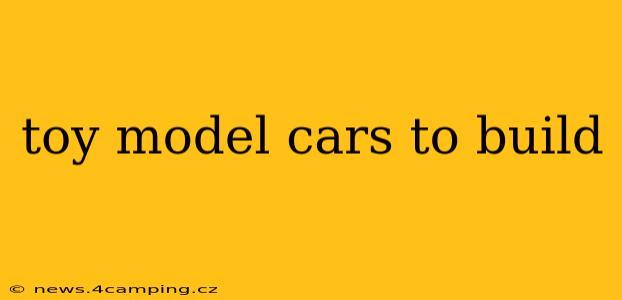Building model cars is a rewarding hobby that combines creativity, patience, and attention to detail. Whether you're a seasoned model builder or a curious beginner, there's a perfect toy model car waiting to be assembled. This guide explores various types of model car kits, considerations for choosing the right one, and tips for a successful build.
What Types of Toy Model Cars Can I Build?
The world of model cars is vast and varied. You can find kits ranging in complexity, scale, and material. Here are some popular categories:
-
Plastic Model Kits: These are the most common type, offering a wide range of vehicles, from classic muscle cars to modern supercars and even military vehicles. They typically involve assembling pre-molded plastic parts, often requiring glue and paint for a finished look. Levels of detail vary greatly, with some kits offering incredibly intricate parts.
-
Metal Model Kits: These kits generally use die-cast metal bodies, offering a robust and realistic feel. Assembly often involves attaching smaller parts made of plastic or resin. They frequently require less painting and glue, making them a good option for beginners.
-
Wooden Model Kits: These offer a unique challenge and reward. Building a wooden model car involves more intricate woodworking skills, requiring careful cutting, shaping, and assembly. The finished product often boasts a unique, handcrafted look.
-
Snap-Together Models: These require no glue or paint, making them ideal for younger builders or those seeking a quicker build. Parts snap together easily, resulting in a satisfyingly quick build, although the level of detail may be less than other options.
What Scale Should I Choose for My Model Car?
Scale refers to the ratio between the model car's size and the real vehicle's size. Popular scales include:
- 1:18 Scale: Offers a great balance between detail and size, making it a popular choice for collectors.
- 1:24 Scale: A common scale, offering good detail at a more manageable size and price point.
- 1:32 Scale: Often used for slot car models, these are smaller and usually less detailed.
- 1:64 Scale: Very small models, perfect for those who want to collect a large number of cars.
How Difficult Are Model Car Kits? What's the Best One for Beginners?
The difficulty of a model car kit varies greatly depending on the brand, scale, and type of kit. Look for kits labeled "easy" or "beginner" for a gentler introduction to the hobby. Snap-together kits, as mentioned previously, are also excellent for beginners. Many manufacturers offer difficulty ratings on their packaging. Start with a smaller, less detailed kit to gain experience before tackling more challenging projects.
What Tools Do I Need to Build a Model Car Kit?
The specific tools needed will depend on the type of kit. However, some common tools include:
- Hobby Knife or Scissors: For carefully cutting parts from sprues (the plastic frames parts are attached to).
- Hobby Glue: Specifically designed for plastic models. Cyanoacrylate ("super glue") is also sometimes used, but needs to be applied carefully.
- Paintbrushes: For applying paint, including fine detail brushes.
- Acrylic Paints: Specifically formulated for model kits.
- Paint Thinner: For cleaning brushes and thinning paints.
- Tweezers: Useful for handling small and delicate parts.
What Are Some Popular Brands of Model Cars?
Many reputable manufacturers produce high-quality model car kits. Some popular brands include Revell, Tamiya, AMT/ERTL, and Fujimi. Each brand has its strengths, ranging from scale offerings to specific vehicle types. Researching different brands will help you discover your preferences.
Where Can I Buy Model Car Kits?
Model car kits are widely available at hobby shops, online retailers (such as Amazon and eBay), and dedicated model building supply websites.
By carefully considering these factors, you'll be well-equipped to select the perfect toy model car kit to embark on your building journey. Happy building!
